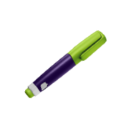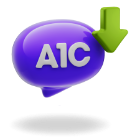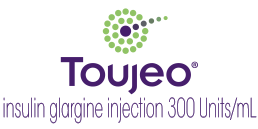What is the Toujeo Max difference?
Only Toujeo® Max SoloStar® contains up to 3X more insulin than standard long-acting insulin pens
*Compared to standard long-acting insulin pens.

May use fewer pens per year
Each pen lasts longer.

Less liquid per injection
Because of the higher concentration.

Potentially less injections
While most standard long-acting insulin pens dial up to 80 units per injection, Toujeo Max dials 2 to 160 units. So, if you take more than 80 units, then switching to Toujeo Max could cut it down to fewer shots.

Toujeo Max can be stored for 8 weeks unrefrigerated once opened†
†Store at room temperature (up to 86°F).
Could you be using too many insulin pens?‡
Enter your daily dose to see how many pens you could save each year with Toujeo Max SoloStar.
Toujeo Max SoloStar is recommended for those who need at least 20 units of long-acting insulin per day.
My daily dose is units
Toujeo Max SoloStar
600-Unit Pens
300-Unit Pens
Not intended to calculate daily dose. Talk with your doctor to find the dose that may be right for you.
‡Does not account for pen priming or safety tests. Always do a safety test before each injection.

“Since I switched to Toujeo Max, I’ve been using fewer pens. And that means I’ve been paying fewer co-pays too!”
JoAnn, on Toujeo since 2019
Individual experiences may vary.

Did you know?
For people who take 50 units a day, a standard long-acting pen with 300 units usually only lasts 6 days.
Toujeo Max SoloStar and Toujeo SoloStar: What’s the difference?

Toujeo Max SoloStar is recommended for those who need at least 20 units of long-acting insulin per day.
Both pens offer you:

Same-size pen

Smallest needle made for insulin pens

5-second hold time

§Toujeo has one-third less volume than any standard long-acting insulin.

95% of patients said Toujeo SoloStar was easy to use.
At the end of a 4-week study of 40 patients, 95% of first-time insulin users with type 2 diabetes rated the Toujeo SoloStar pen as easy to use.
All patients in the study were trained on how to use the pen. It is important to ask your healthcare provider to show you how to use the pen before using it.
Learn how to use the Toujeo SoloStar and Toujeo Max SoloStar pens
That is an "actual patient"
- Toujeo is not for the treatment of diabetic ketoacidosis
- It is not known if Toujeo is safe and effective in children under 6 years of age
- Shortness of breath
- Sudden weight gain
- Swelling of your ankles or feet
- A rash over your whole body
- Shortness of breath
- Swelling of your face, tongue, or throat
- Extreme drowsiness, dizziness, or confusion
- Trouble breathing
- Fast heartbeat
- Sweating
ANNOUNCER: These instructions do not replace the guidance of your doctor or the instructions for use that accompanies the Toujeo® SoloStar® (insulin glargine) injection 300 Units/mL or Toujeo® Max SoloStar® pens. People who have vision problems should not use the Toujeo SoloStar or Toujeo Max SoloStar pen without help from a person trained to use the respective pens.
MAX AMY: In this diabetes journey we’re on, have you ever wished you could go back in time and tell yourself the things that you know now, but you didn’t know then?
MAX AMY: Thanks to the wonders of modern technology, we can.
Prescription Toujeo is a long-acting man-made insulin used to control high blood sugar in adults and children who are 6 years of age and older with diabetes mellitus. • Toujeo is not for the treatment of diabetic ketoacidosis • It is not known if Toujeo is safe and effective in children under 6 years of age
Do not use Toujeo if you have low blood sugar or if you are allergic to insulin or any of the ingredients in Toujeo.
Do not share your pen(s) with other people, even if the needle has been changed.
MAX AMY: Hey look at that, our first SoloStar pen! I remember that.
MAX AMY: It was a really big deal when I came home with my first pen – it feels like it was only yesterday.
PAST AMY: Oh hey, is that one the same as this one?
MAX AMY: Well your pen is the SoloStar. This one is the Max SoloStar. They’re very similar but there’re some really important differences – but I’ll get to those in a second.
MAX AMY: Did your doctor show you how to use it?
PAST AMY: Yeah, she showed me, but now that I’m home I still have some questions.
MAX AMY: Let me help you get the hang of this.
MAX AMY: There are six steps you need to know: Check the pen, attach the needle, test for safety, select the dosage, inject the insulin, and then remove the needle.
PAST AMY [repeating as if memorizing]: OK. Check the pen, attach the needle, test for safety, select the dosage, inject the insulin, and remove the needle.
MAX AMY: That’s it! You’re ahead of the game already! I knew there was a reason why I liked you.
MAX AMY: So before we do anything, we’re going to make sure the pen is at room temperature, that we have the correct pen, and that it’s working properly.
MAX AMY: Did you take the pen out of the refrigerator about an hour ago? 'Cause cold insulin can be painful…
PAST AMY: Really? Who knew?
MAX AMY: You.
PAST AMY: Good point. This one’s been out of the fridge about an hour.
MAX AMY: Now look at your pen. I mean, really look at it.
MAX AMY: Is that your pen?
PAST AMY: Yeah.
MAX AMY: Great. Take off the pen cap and check the insulin. It’s clear, not cloudy?
PAST AMY: Clear.
MAX AMY: Perfect! If the insulin’s cloudy, don’t use it, just take it back to your pharmacy.
MAX AMY: Is it past the use-by date?
PAST AMY: Nope.
MAX AMY: Great! Now it’s time to attach the needle.
MAX AMY: Remember, you’re going to need a fresh needle every time you use the pen.
MAX AMY: Don’t reuse and never share needles.
PAST AMY: Even with you?
MAX AMY: Yes, even with me.
PAST AMY: What kind of needles can I use?
MAX AMY: These kind.
MAX AMY: Before you attach the needle, sterilize the tip of the pen with an alcohol wipe.
MAX AMY: Then with the needle you’re going to peel off the protective seal and screw the needle onto the pen, until it feels fixed.
MAX AMY: Then you’re going to remove the outer cap and put that somewhere safe. Then remove the inner needle cap and throw it in the trash.
PAST AMY: Keep the outer cap, toss the inner, got it.
MAX AMY: That’s step two done! With me so far?
PAST AMY: I’m with you.
MAX AMY: Yes, you are. So, before we do anything else, we need to make sure the pen’s working properly.
PAST AMY: What could go wrong?
MAX AMY: Well, sometimes the insulin won’t come out, so we usually check for that.
PAST AMY: OK.
MAX AMY: Testing the pen also resets the dosage knob which is also important.
PAST AMY: Great, so how do I do that?
MAX AMY: Turn the dosage dial to 3, then you’re going to hold it straight up and you’re going to press the injection button all the way in.
MAX AMY: If you see insulin coming out of the needle, then the pen is working and you’re good to go.
MAX AMY: However, if you don’t see insulin coming out, repeat that last step again.
MAX AMY: If you have a new pen, you may need to do this up to six times. Just to get that working. If it still doesn’t work, you need to replace the needle.
PAST AMY: Like in step two?
MAX AMY: Precisely. Oh and by the way, if you see bubbles in your insulin, don’t sweat it.
PAST AMY: Aren’t bubbles in injections bad?
MAX AMY: Nope, not here. You’ve been watching too much TV.
MAX AMY: Ready to inject some insulin?
PAST AMY: OK.
MAX AMY: First, we need to select the correct dosage. So we’re going to turn the dosage selector to your dose.
MAX AMY: Whatever you and your doctor discussed is what you turn the dial to.
PAST AMY: OK, I need 38 units, so I turn the dial to 38, correct?
MAX AMY: Correct.
MAX AMY: Now this is important: If you have the SoloStar pen, the increments on the dial are one click for one unit, but on the Max SoloStar pen, it’s one click for two units.
MAX AMY: So don’t dial your dose by counting the clicks, or you may dial the wrong dose.
MAX AMY: Either way, just turn the dial so your prescribed dose appears in this window. If there’s not enough insulin in the pen for your prescribed dose, you’ll only be able to dial to the amount that’s left in the pen, and then you’ll need to supplement with a new pen.
PAST AMY: How do I know whether I need the SoloStar or the Max SoloStar?
MAX AMY: As your diabetes changes, your dose may change too, so your doctor may recommend you use a Max SoloStar. Like me.
PAST AMY: That makes total sense.
MAX AMY: OK, we’re in the home stretch.
MAX AMY: Are you ready for your injection?
PAST AMY: Where can I inject?
MAX AMY: You can inject your dose here, here or here.
MAX AMY: Push the needle into your skin, but don’t touch the injection button yet.
MAX AMY: Put your thumb on the button, press all the way in and hold.
MAX AMY: Hold the button in. When you see “0” in the window, then count to five to make sure you get your full dose.
MAX AMY: After counting to five, release the button and remove the needle from your skin.
PAST AMY: OK, that was pretty easy.
PAST AMY: Well, I barely noticed it at all. How do they do that?
MAX AMY: Thin needles.
MAX AMY: We’re almost done. Now we just need to remove the needle and throw it away safely.
PAST AMY: This really is pretty straightforward.
MAX AMY: I know, right?
MAX AMY: To remove the needle, get the outer needle cap we set aside earlier and carefully place it back on the pen. You put that somewhere safe, right?
PAST AMY: Yep.
MAX AMY: OK.
MAX AMY: These things are sharp. Avoid puncturing the cap, 'cause it will go through.
MAX AMY: Grip and squeeze the widest part of the outer needle cap, then turn your pen several times with your other hand to remove the needle.
PAST AMY: But what if it doesn’t come off right away?
MAX AMY: Just keep trying, it’ll come off eventually.
MAX AMY: Once the needle’s been removed, then we dispose of it in a puncture resistant container.
PAST AMY: Can I just leave the needle on and use it again later?
MAX AMY: No, that’s not a great idea for several reasons: It can leak or get clogged if you leave it on, air could get into the insulin, and there’s the possibility of a bacterial infection.
PAST AMY: So, do I need to put the pen back in the refrigerator when I’m done?
MAX AMY: Nope, that’s the great thing about these pens – you’re good for up to eight weeks after your first use without refrigeration.
PAST AMY: Well that’s handy.
MAX AMY: It sure is.
MAX AMY: So, there you go. That’s all six steps of how to use the Toujeo SoloStar and Max SoloStar insulin pens.
MAX AMY: Just to recap, we learned how to check the pen, attach the needle, test for safety, select your dosage, inject the insulin, and then remove the needle.
PAST AMY: Hey, that was really straightforward. I know the doctor explained it to me, but it really helped to have you explain it again.
MAX AMY: No sweat.
PAST AMY: You know, now that I know, it’s pretty simple. If I wasn’t so nervous, I guess I could have taught myself to do it.
MAX AMY: Well, you know, you kinda did.
ANNOUNCER: An unopened Toujeo SoloStar or Toujeo Max SoloStar pen should be stored in the refrigerator with the pen cap on, at a temperature between 36 degrees Fahrenheit and 46 degrees Fahrenheit (2 degrees Celsius and 8 degrees Celsius) in the box it came in.
Do not freeze new pens.
Refrigerate pens until expiration date.
Discard pens after the expiration date.
An opened Toujeo SoloStar or Toujeo Max SoloStar pen should be stored at room temperature below 86 degrees Fahrenheit (30 degrees Celsius).
Do not refrigerate an opened pen.
Keep out of direct heat and light.
Do not store your pen with the needle attached.
Store your pen with the pen cap on.
Keep pens and needles out of the reach of children.
Discard 56 days after first use, even if the pen still contains insulin.
What is Toujeo U-300 (insulin glargine) injection 300 Units/mL?
Prescription Toujeo is a long-acting man-made insulin used to control high blood sugar in adults and children who are 6 years of age and older with diabetes mellitus.
Important Safety Information for Toujeo U-300 (insulin glargine) injection
Do not use Toujeo if you have low blood sugar or if you are allergic to insulin or any of the ingredients in Toujeo.
Do not share your pen(s) with other people, even if the needle has been changed. You may give other people a serious infection or get a serious infection from them.
Before starting Toujeo, tell your doctor about all your medical conditions, including if you have liver or kidney problems, if you are pregnant or planning to become pregnant, or if you are breastfeeding or planning to breastfeed.
Change (rotate) your injection sites within the area you chose with each dose to reduce your risk of getting pitted or thickened skin (lipodystrophy) and skin with lumps (localized cutaneous amyloidosis) at the injection sites. Do not use the same spot for each injection or inject where the skin is pitted, thickened, lumpy, tender, bruised, scaly, hard, scarred, or damaged.
Heart failure can occur if you are taking insulin together with pills called TZDs (thiazolidinediones), even if you have never had heart failure or other heart problems. If you have heart failure, it may get worse while you take TZDs with Toujeo. Your treatment with TZDs and Toujeo may need to be changed or stopped by your doctor if you have new or worsening heart failure. Tell your doctor if you have any new or worsening symptoms including:
Tell your doctor about all the medications you take, including OTC medicines, vitamins, and supplements, and herbal supplements.
Toujeo should be taken at the same time once a day. Test your blood sugar levels daily while using any insulin. Do not change your dose or type of insulin without talking to your doctor. Verify you have the correct insulin before each injection. Do NOT use a syringe to remove Toujeo from your pen. Your dose for Toujeo may be different from other insulins you have taken. Any change of insulin should be made cautiously and only under medical supervision.
Do NOT dilute or mix Toujeo with any other insulin or solution. It will not work as intended and you may lose blood sugar control, which could be serious. Use Toujeo only if the solution is clear and colorless with no particles visible.
While using Toujeo, do not drive or operate heavy machinery until you know how Toujeo affects you. Don’t drink alcohol or use other medicines that contain alcohol.
The most common side effect of Toujeo is low blood sugar (hypoglycemia), which may be serious and life-threatening. Severe hypoglycemia may cause harm to your heart or brain. Symptoms of serious low blood sugar may include shaking, sweating, fast heartbeat, and blurred vision. The long-acting effect of Toujeo may delay recovery from low blood sugar compared to shorter-acting insulins.
Toujeo may cause severe allergic reactions that can lead to death. Get medical help right away if you have:
Toujeo may have additional side effects including swelling, weight gain, low potassium, and injection site reactions which may include change in fat tissue, skin thickening, redness, swelling, and itching.
Toujeo SoloStar and Toujeo Max SoloStar are single-patient-use prefilled insulin pens. It is important to perform a safety test when using a new pen for the first time. Talk to your doctor about proper injection technique and follow instructions in the Instruction Leaflet that comes with your Toujeo SoloStar or Toujeo Max SoloStar pen.
©2025 Sanofi.
All rights reserved
MAT-US-2006936-v2.0-11/2022
Back to Video

Your Toujeo Injection Guide
An easy to follow, step-by-step guide for using Toujeo pens.
Most common and serious side effects
When taking any medication, it’s important to understand how it might affect your body, and Toujeo is no different. Before startng Toujeo, talk to your doctor about all the possible side effects.

For all insulins, including Toujeo, the most common side effect is hypoglycemia. Ask your doctor about the signs and symptoms of hypoglycemia, how to monitor your blood sugar, and what to do if you have a hypoglycemic event.

Toujeo may cause serious side effects including severe allergic reactions. Get medical help right away if you have:
- A rash over your whole body
- Trouble breathing
- Fast heartbeat
- Sweating
- Shortness of breath
- Swelling of your face, tongue, or throat
- Extreme drowsiness, dizziness, or confusion
These are not all the possible side effects of Toujeo. Talk with your doctor about possible side effects.
For more detailed information, see the full Important Safety Information and full Prescribing Information.
Also keep in mind
Do not use a syringe to remove Toujeo from your SoloStar disposable prefilled pen. Never reuse needles or share insulin pens even if the needle has been changed.
How to have a conversation with your doctor about insulin treatment
If your doctor is suggesting an insulin for you, your diabetes may have changed. And because diabetes is a progressive disease, sometimes you’ll need to adjust the dose of your medicine. It’s important to take an active role in the management of your diabetes. So, feel confident to advocate for yourself and have a good conversation with your doctor.
To help you get the most out of your next visit, download the guide below that best matches where you are in your treatment journey. Whether you are new to insulin or switching from another pen to Toujeo Max SoloStar, these guides may help.
Be sure to bring to your next doctor’s appointment:
 Insurance card
Insurance card
 Physician referral (if you’re seeing a specialist)
Physician referral (if you’re seeing a specialist)
 Medical history
Medical history
 Names and dosages of current medications
Names and dosages of current medications
 Blood sugar daily log
Blood sugar daily log
Download your Toujeo Starter Kit with resources

Pay no more than $35* per month for Toujeo Max
Whether you have commercial insurance or not, or prefer to pay cash outside of your prescription drug benefit, we have an offer for you.

Proven A1C reduction
Toujeo Max could help you control your A1C.
What is Toujeo U-300 (insulin glargine) injection 300 Units/mL?
Prescription Toujeo is a long-acting man-made insulin used to control high blood sugar in adults and children who are 6 years of age and older with diabetes mellitus.
- Toujeo is not for the treatment of diabetic ketoacidosis
- It is not known if Toujeo is safe and effective in children under 6 years of age
Important Safety Information
Important Safety Information
Do not use Toujeo if you have low blood sugar or if you are allergic to insulin or any of the ingredients in Toujeo.
Do not share your pen(s) with other people, even if the needle has been changed. You may give other people a serious infection or get a serious infection from them.
Before starting Toujeo, tell your doctor about all your medical conditions, including if you have liver or kidney problems, if you are pregnant or planning to become pregnant, or if you are breastfeeding or planning to breastfeed.
Change (rotate) your injection sites within the area you chose with each dose to reduce your risk of getting pitted or thickened skin (lipodystrophy) and skin with lumps (localized cutaneous amyloidosis) at the injection sites. Do not use the same spot for each injection or inject where the skin is pitted, thickened, lumpy, tender, bruised, scaly, hard, scarred, or damaged.
Heart failure can occur if you are taking insulin together with pills called TZDs (thiazolidinediones), even if you have never had heart failure or other heart problems. If you have heart failure, it may get worse while you take TZDs with Toujeo. Your treatment with TZDs and Toujeo may need to be changed or stopped by your doctor if you have new or worsening heart failure. Tell your doctor if you have any new or worsening symptoms including:
- Shortness of breath
- Sudden weight gain
- Swelling of your ankles or feet
Tell your doctor about all the medications you take, including OTC medicines, vitamins, and supplements, and herbal supplements.
Toujeo should be taken at the same time once a day. Test your blood sugar levels daily while using any insulin. Do not change your dose or type of insulin without talking to your doctor. Verify you have the correct insulin before each injection. Do NOT use a syringe to remove Toujeo from your pen. Your dose for Toujeo may be different from other insulins you have taken. Any change of insulin should be made cautiously and only under medical supervision.
Do NOT dilute or mix Toujeo with any other insulin or solution. It will not work as intended and you may lose blood sugar control, which could be serious. Use Toujeo only if the solution is clear and colorless with no particles visible.
While using Toujeo, do not drive or operate heavy machinery until you know how Toujeo affects you. Don’t drink alcohol or use other medicines that contain alcohol.
The most common side effect of Toujeo is low blood sugar (hypoglycemia), which may be serious and life-threatening. Severe hypoglycemia may cause harm to your heart or brain. Symptoms of serious low blood sugar may include shaking, sweating, fast heartbeat, and blurred vision. The long-acting effect of Toujeo may delay recovery from low blood sugar compared to shorter-acting insulins.
Toujeo may cause severe allergic reactions that can lead to death. Get medical help right away if you have:
- A rash over your whole body
- Shortness of breath
- Swelling of your face, tongue, or throat
- Extreme drowsiness, dizziness, or confusion
- Trouble breathing
- Fast heartbeat
- Sweating
Toujeo may have additional side effects including swelling, weight gain, low potassium, and injection site reactions which may include change in fat tissue, skin thickening, redness, swelling, and itching.
Toujeo SoloStar and Toujeo Max SoloStar are single-patient-use prefilled insulin pens. It is important to perform a safety test when using a new pen for the first time. Talk to your doctor about proper injection technique and follow instructions in the Instruction Leaflet that comes with your Toujeo SoloStar or Toujeo Max SoloStar pen.
†Eligibility Restrictions & Offer Terms:
Sanofi Insulins Co-pay Savings Program: This savings program is not insurance. For a complete list of participating brands, products, and National Drug Codes (NDCs) Click Here. This offer is not valid for prescriptions covered by or submitted for reimbursement, in whole or in part, under Medicare, Medicaid, VA, DOD, TRICARE, similar federal or state programs, including any state pharmaceutical programs. If you have an Affordable Care (Health Care Exchange) plan, you may still be qualified to receive and use this savings card. Please note: the Federal Employees Health Benefits (FEHB) Program is not a federal or state government health care program for purposes of the savings program. Void where prohibited by law. For the duration of the program, eligible commercially insured patients pay no more than $35 per 30-day supply, up to 10 packs per fill; Offer valid for one fill every 30 days. Savings may vary depending on patients’ out-of-pocket costs. The Sanofi Insulins Co-pay Savings Program applies to the cost of medication. There are other relevant costs associated with overall treatment. Sanofi reserves the right to rescind, revoke, terminate, or amend this offer, eligibility, and terms of use at any time without notice. Upon registration, patients will receive all program details. For questions regarding your eligibility or benefits, or if you wish to discontinue your participation, call the Sanofi Insulins Co-pay Savings Program at (866) 255-8661 (866) 255-8661 (9:00 am-7:00 pm EST, Monday-Friday).
Insulins Valyou Savings Program: This savings program is not insurance. For a complete list of participating brands, products, and National Drug Codes (NDCs) Click Here. This offer is only valid for those who are uninsured or those who are insured by a prescription plan but are not using such insurance and will be paying the full retail price for the medication. Void where prohibited by law. The Savings Program applies to the cost of medication. There are other relevant costs associated with overall treatment. You may not submit claims for reimbursement to any third-party payor, including any government healthcare plan (e.g., Medicare, Medicaid, DOD, VA, TRICARE) or similar federal or state programs for Sanofi Insulin prescriptions when using this Program. You may not seek to have your out-of-pocket costs or the full retail price of the Sanofi Insulin count toward your deductible, true-out-of-pocket (TrOOP), maximum out-of-pocket (MOOP), or any other out-of-pocket caps associated with any insurance coverage. Sanofi reserves the right to rescind, revoke, terminate, or amend this offer, eligibility, and terms of use at any time without notice. Upon registration, patients will receive all program details. For questions regarding your eligibility or benefits, or if you wish to discontinue your participation, call the Insulins Valyou Savings Program at (833) 813-0190 (833) 813-0190 (9:00 am-7:00 pm EST, Monday-Friday).
Important Safety Information
Do not use Toujeo if you have low blood sugar or if you are allergic to insulin or any of the ingredients in Toujeo.
Do not share your pen(s) with other people, even if the needle has been changed. You may give other people a serious infection or get a serious infection from them.
Before starting Toujeo, tell your doctor about all your medical conditions, including if you have liver or kidney problems, if you are pregnant or planning to become pregnant, or if you are breastfeeding or planning to breastfeed.
Change (rotate) your injection sites within the area you chose with each dose to reduce your risk of getting pitted or thickened skin (lipodystrophy) and skin with lumps (localized cutaneous amyloidosis) at the injection sites. Do not use the same spot for each injection or inject where the skin is pitted, thickened, lumpy, tender, bruised, scaly, hard, scarred, or damaged.
Heart failure can occur if you are taking insulin together with pills called TZDs (thiazolidinediones), even if you have never had heart failure or other heart problems. If you have heart failure, it may get worse while you take TZDs with Toujeo. Your treatment with TZDs and Toujeo may need to be changed or stopped by your doctor if you have new or worsening heart failure. Tell your doctor if you have any new or worsening symptoms including:
- Shortness of breath
- Sudden weight gain
- Swelling of your ankles or feet
Tell your doctor about all the medications you take, including OTC medicines, vitamins, and supplements, and herbal supplements.
Toujeo should be taken at the same time once a day. Test your blood sugar levels daily while using any insulin. Do not change your dose or type of insulin without talking to your doctor. Verify you have the correct insulin before each injection. Do NOT use a syringe to remove Toujeo from your pen. Your dose for Toujeo may be different from other insulins you have taken. Any change of insulin should be made cautiously and only under medical supervision.
Do NOT dilute or mix Toujeo with any other insulin or solution. It will not work as intended and you may lose blood sugar control, which could be serious. Use Toujeo only if the solution is clear and colorless with no particles visible.
While using Toujeo, do not drive or operate heavy machinery until you know how Toujeo affects you. Don’t drink alcohol or use other medicines that contain alcohol.
The most common side effect of Toujeo is low blood sugar (hypoglycemia), which may be serious and life-threatening. Severe hypoglycemia may cause harm to your heart or brain. Symptoms of serious low blood sugar may include shaking, sweating, fast heartbeat, and blurred vision. The long-acting effect of Toujeo may delay recovery from low blood sugar compared to shorter-acting insulins.
Toujeo may cause severe allergic reactions that can lead to death. Get medical help right away if you have:
- A rash over your whole body
- Shortness of breath
- Swelling of your face, tongue, or throat
- Extreme drowsiness, dizziness, or confusion
- Trouble breathing
- Fast heartbeat
- Sweating
Toujeo may have additional side effects including swelling, weight gain, low potassium, and injection site reactions which may include change in fat tissue, skin thickening, redness, swelling, and itching.
Toujeo SoloStar and Toujeo Max SoloStar are single-patient-use prefilled insulin pens. It is important to perform a safety test when using a new pen for the first time. Talk to your doctor about proper injection technique and follow instructions in the Instruction Leaflet that comes with your Toujeo SoloStar or Toujeo Max SoloStar pen.
†Eligibility Restrictions & Offer Terms:
Sanofi Insulins Co-pay Savings Program: This savings program is not insurance. For a complete list of participating brands, products, and National Drug Codes (NDCs) Click Here. This offer is not valid for prescriptions covered by or submitted for reimbursement, in whole or in part, under Medicare, Medicaid, VA, DOD, TRICARE, similar federal or state programs, including any state pharmaceutical programs. If you have an Affordable Care (Health Care Exchange) plan, you may still be qualified to receive and use this savings card. Please note: the Federal Employees Health Benefits (FEHB) Program is not a federal or state government health care program for purposes of the savings program. Void where prohibited by law. For the duration of the program, eligible commercially insured patients pay no more than $35 per 30-day supply, up to 10 packs per fill; Offer valid for one fill every 30 days. Savings may vary depending on patients’ out-of-pocket costs. The Sanofi Insulins Co-pay Savings Program applies to the cost of medication. There are other relevant costs associated with overall treatment. Sanofi reserves the right to rescind, revoke, terminate, or amend this offer, eligibility, and terms of use at any time without notice. Upon registration, patients will receive all program details. For questions regarding your eligibility or benefits, or if you wish to discontinue your participation, call the Sanofi Insulins Co-pay Savings Program at (866) 255-8661 (866) 255-8661 (9:00 am-7:00 pm EST, Monday-Friday).
Insulins Valyou Savings Program: This savings program is not insurance. For a complete list of participating brands, products, and National Drug Codes (NDCs) Click Here. This offer is only valid for those who are uninsured or those who are insured by a prescription plan but are not using such insurance and will be paying the full retail price for the medication. Void where prohibited by law. The Savings Program applies to the cost of medication. There are other relevant costs associated with overall treatment. You may not submit claims for reimbursement to any third-party payor, including any government healthcare plan (e.g., Medicare, Medicaid, DOD, VA, TRICARE) or similar federal or state programs for Sanofi Insulin prescriptions when using this Program. You may not seek to have your out-of-pocket costs or the full retail price of the Sanofi Insulin count toward your deductible, true-out-of-pocket (TrOOP), maximum out-of-pocket (MOOP), or any other out-of-pocket caps associated with any insurance coverage. Sanofi reserves the right to rescind, revoke, terminate, or amend this offer, eligibility, and terms of use at any time without notice. Upon registration, patients will receive all program details. For questions regarding your eligibility or benefits, or if you wish to discontinue your participation, call the Insulins Valyou Savings Program at (833) 813-0190 (833) 813-0190 (9:00 am-7:00 pm EST, Monday-Friday).


